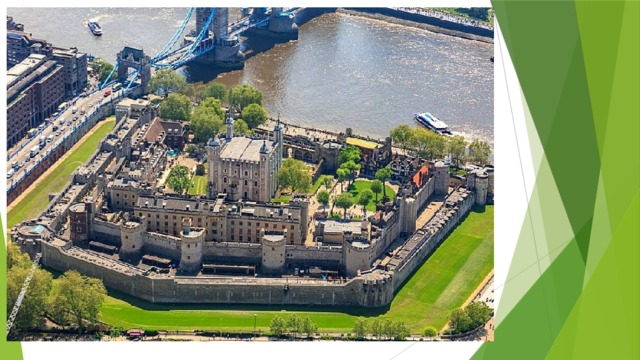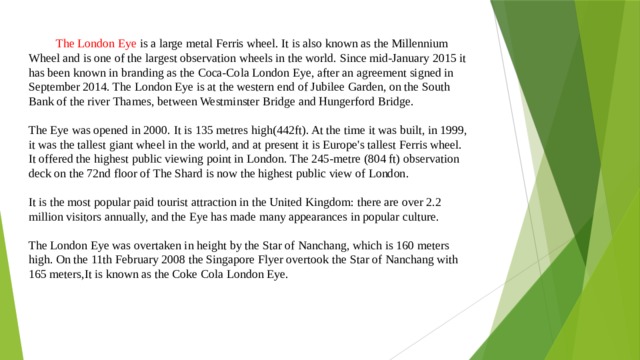
Презентация на тему: «Лондон»
Подготовил:
Учитель английского языка
МКОУ «ООШ№14»
Ю.Н Мельникова
Г.Миасс, 2020г

See the London…..



Short History of London
London is an old city.
It grew up around the first point where the Roman invaders found the Thames narrow enough to build a bridge. There has been a “London Bridge” in the same area ever since.
They founded a Celtic settlement then known as Londinium and later they had turned it into a large port and important trading centre with a long wall of stone and brick. Inside the wall low houses were built with bright red tiled roofs.
The Tower of London was founded by Julius Caesar and in 1066 rebuilt by William the Conqueror. It was used as a fortress, a royal residence and a prison. Now it is a museum and also the place where the Crown Jewels are kept.
Time passed. London grew and became a great city. The coming of the railway changed London for ever. The first underground railway was opened in 1863 between Paddington and the City.
Today London is the capital of Great Britain and Northern Ireland. It is one of the most beautiful cities in the world.
There are many places of interest in it and this city is well worth visiting.

Достопримечательности

Big Ben is one of the most popular places of interest in London and symbols of England. Every year many people visit the capital of Great Britain to see it and take some photos with it in the background. It is thought that Big Ben is a high tower with a very big clock, but that’s not really true.

In fact, this tower is called Saint Stephens Tower, but people, even those who live in the UK, are used to calling it "Big Ben." Actually, Big Ben is the huge bell inside the building. Its weight is about thirteen tons and it rings every hour daily: once at one o'clock, twice at two o'clock and so on. However, people who live near the tower can hear at New Year’s Night how the bell strikes thirteen. It’s considered to be the biggest bell ever made in the country. The bell was firstly used in 1859 and was cracked soon because of the heavy hammer, which struck too strong. After this situation the hammer was changed, but that crack is still there.
There are many hypotheses for the origin of the name “Big Ben”. The most popular one suggests that the bell was named after Sir Benjamin Hall, who was responsible for the installation. Some of people say he was really tall and that’s why this bell is called big, but the majority believe it is called Big because of its size.
Big Ben is one of the best-known landmarks in Europe. Nowadays the word Big Ben connects the bell, the clock and the tower at the same time. The tower is closed to the general public, but people with a "special interest" might offer an excursion for additional payment.

The Tower of London is one of the most famous and most interesting places in the city. The Tower was once a palace, a fortress, a prison and even a Zoo. Today it is known as a historical museum. Despite being called “The Tower of London”, the place consists of 20 towers. The White Tower is the oldest of them. It was built at the time of William the Conqueror. The Tower of London used to be a place where many famous people lived their last days before execution. Anne Boleyn was beheaded there and future Queen Elizabeth was kept in the prison but later she was released and became Queen. The guardians of the Tower still tell tourists many thrilling stories about things happened there when the place was a prison. Even a more interesting story is considered to be the one about the start of the Zoo. It is said that King Henry III was given an elephant, a polar bear and several leopards as gifts and he had no place to keep them in except for the Tower of London. Nowadays the Tower of London is a place of great interest for millions of people. Tourists come there to visit the museum of Royal Armouries, the Fusilier museum and a new Jewel Tower where Crown Jewels are exhibited. Tourists can also speak with the guardians who wear special uniform which was assigned to them during the reign of Queen Elizabeth I.


Globe Theatre , famous London theatre in which after 1599 the plays of William Shakespeare were performed.
Early in 1599 Shakespeare, who had been acting with the Lord Chamberlain’s Men since 1594, paid into the coffers of the company a sum of money amounting to 12.5 percent of the cost of building the Globe. He did so as a chief shareholder in the company, and by doing so he helped to establish a uniquely successful form of commercial operation for the actors of the time. This investment gave Shakespeare and the other leading actors both a share in the company’s profits and a share in their playhouse.
At this time, officially approved playhouses and officially approved acting companies had been in existence in London for only five years. The Lord Chamberlain’s Men was one of only two companies licensed to perform within the London city limits. (For more on this subject, see Sidebar: Shakespeare and the Liberties.) The other company used the Rose playhouse, owned by an impresario and his ex-actor son-in-law.

Shakespeare’s company built the Globe only because it could not use the special roofed facility, Blackfriars Theatre, that James Burbage (the father of their leading actor, Richard Burbage) had built in 1596 for it inside the city. The elder Burbage had a long history as a theatrical entrepreneur. In 1576 he had built the first successful amphitheatre, known as The Theatre, in a London suburb. Twenty years later, when the lease on The Theatre’s land was about to expire, he built the theatre in Blackfriars as its replacement. But the wealthy residents of Blackfriars persuaded the government to block its use for plays, so Burbage’s capital was locked up. He died early in 1597, his plans for the future of theatre in London frustrated.

Trafalgar Square
This is one of the nerve-centres of London. It was named Trafalgar Square to commemorate the historical naval victory won on the 21st of October 1805 by the British fleet under the command of Horatio Nelson over the combined French-Spanish fleet commanded by Villeneuve. The battle took place at Cape Trafalgar in the mouth of the Straits of Gibraltar and lasted several hours. Nelson was fatally wounded by a shot which broke his backbone. He died on board his flagship the Victory, but not before being told that he had won the battle.
Nelson's Column, with the statue of Admiral Lord Nelson on top, rises in the centre of Trafalgar Square. This most impressive monument is 170 feet (about 52 m) tall. The statue of Nelson, placed facing towards the sea he loved, measures 17 feet (more than 5 m) in height.
To the north-east of Trafalgar Square there is the building that houses the National Gallery of Art - one of the most important Art Galleries in the world - and behind is the National Portrait Gallery.
Quite often the square becomes the location for meetings and in it crowds of Londoners congregate to celebrate political rallies. So it can be said that Trafalgar Square is the heart from which the beat is emitted to all the Londoners.
There are many pigeons in the square and Londoners like to feed them. Everybody knows that the dove is the symbol of peace all over the world.


The London Eye is a large metal Ferris wheel. It is also known as the Millennium Wheel and is one of the largest observation wheels in the world. Since mid-January 2015 it has been known in branding as the Coca-Cola London Eye, after an agreement signed in September 2014. The London Eye is at the western end of Jubilee Garden, on the South Bank of the river Thames, between Westminster Bridge and Hungerford Bridge.
The Eye was opened in 2000. It is 135 metres high(442ft). At the time it was built, in 1999, it was the tallest giant wheel in the world, and at present it is Europe's tallest Ferris wheel. It offered the highest public viewing point in London. The 245-metre (804 ft) observation deck on the 72nd floor of The Shard is now the highest public view of London.
It is the most popular paid tourist attraction in the United Kingdom: there are over 2.2 million visitors annually, and the Eye has made many appearances in popular culture.
The London Eye was overtaken in height by the Star of Nanchang, which is 160 meters high. On the 11th February 2008 the Singapore Flyer overtook the Star of Nanchang with 165 meters,It is known as the Coke Cola London Eye.

![Buckingham Palace is a palace in the City of Westminster, which is part of central London, England in the United Kingdom. It is the official residence where the British monarch lives and works.[1] The palace is a setting for state occasions and royal hospitality, and has been a focus for the British people at times of national rejoicing and crisis. Buckingham Palace was built in 1703 by John Sheffield, 1st Duke of Buckingham and Normandy, as a townhouse (a residence in London). It was bought by the British royal family in 1761. It became the official London home of the family in 1837 and was greatly expanded in the 19th century. It has 775 rooms, 19 staterooms, and 78 bathrooms. Leading up to it is a ceremonial road called The Mall. A German bomb damaged the Palace during the London blitz.The palace's guard is changed every day at 11am.](https://fsd.videouroki.net/html/2020/06/16/v_5ee8505255ac2/img16.jpg)
Buckingham Palace is a palace in the City of Westminster, which is part of central London, England in the United Kingdom. It is the official residence where the British monarch lives and works.[1] The palace is a setting for state occasions and royal hospitality, and has been a focus for the British people at times of national rejoicing and crisis.
Buckingham Palace was built in 1703 by John Sheffield, 1st Duke of Buckingham and Normandy, as a townhouse (a residence in London). It was bought by the British royal family in 1761. It became the official London home of the family in 1837 and was greatly expanded in the 19th century. It has 775 rooms, 19 staterooms, and 78 bathrooms. Leading up to it is a ceremonial road called The Mall. A German bomb damaged the Palace during the London blitz.The palace's guard is changed every day at 11am.

The British Museum in London is one of the world's largest and most important museums of human history and culture. It has more than seven million objects from all continents. They illustrate and document the story of human culture from its beginning to the present. As with all other national museums and art galleries in Britain, the Museum charges no admission fee.
The British Museum set up in 1753 and opened in 1759. It was the first museum in the world to be open to everyone. The museum gradually grew over the next two hundred years. It has nearly six million visitors a year and is the third most popular art museum in the world.
Some of the museum's most popular and important exhibits include the Rosetta Stone and the Elgin Marbles.
The history of the British Museum began with the Irish born British physicist Hans Sloane, who died aged 93 in 1753. During his life, he had collected many important things from all around the world. When he died, he did not want his collection to be split up between his relatives. He sold his collection to the parliament of King George II. The parliament set up the British Museum to hold the collection. By the time he died, Sloane had collected over 80,000 objects from all over the world including Egypt, Greece, Rome and the Americas. The collection was mostly books and manuscripts. There were many important archaeological pieces included as well.

The Rosetta Stone on display in the Museum in 1874.
The government looked at many possible places to build the new museum, including Buckingham House, which later became Buckingham Palace. Eventually a building called Montagu House was chosen. The Museum opened on 15 January 1759, although all visitors had to be shown around by stewards. Over the years the museum began to concentrate more and more on historical objects and sculptures. For this reason they were given the Rosetta Stone by King George III in 1802. The Rosetta Stone had previously been important to French historians trying understand the Hieroglyph language written by the Ancient Egyptians. In 1816 the Museum acquired the Elgin Marbles from Thomas Bruce, 7th Earl of Elgin. Elgin had taken them from the Parthenon in Athens, Greece several years earlier. Many people disagreed with the way Elgin took them from Greece. They compared his acts to looting and vandalism. People still argue about this issue today. In 1822 King George III donated the entire Royal Library to the museum. This contained over 65,000 books and pamphlets. In 1823 the original building was demolished and work began on new buildings to hold the ever growing collection. Some of the space was freed up when the National Gallery opened in 1824, as many of the Museum's paintings and drawings were moved there.


 Получите свидетельство
Получите свидетельство Вход
Вход












 "Достопримечательности Лондона" (4.76 MB)
"Достопримечательности Лондона" (4.76 MB)
 0
0 46
46 3
3 Нравится
0
Нравится
0


